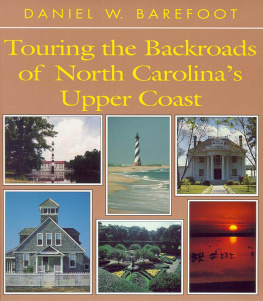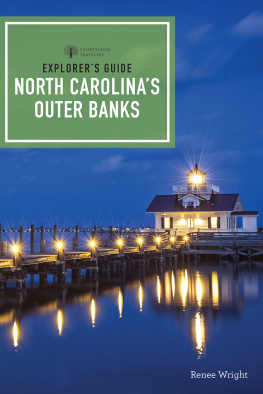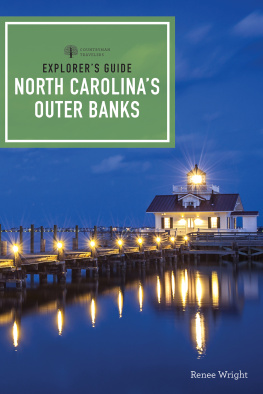

ALSO BY DANIEL W. BAREFOOT
Touring the Backroads of North Carolinas Lower Coast
OTHER TITLES IN JOHN F. BLAIRS TOURING THE BACKROADS SERIES
Touring the Western North Carolina Backroads by Carolyn Sakowski
Touring the East Tennessee Backroads by Carolyn Sakowski
Touring the Coastal South Carolina Backroads by Nancy Rhyne
Touring the Coastal Georgia Backroads by Nancy Rhyne
Touring the Backroads of North Carolinas Lower Coast by Daniel W. Barefoot
Touring the Middle Tennessee Backroads by Robert Brandt

Copyright 1995 by John F. Blair, Publisher
Printed in the United States of America
All Rights Reserved
BOOK DESIGN BY DEBRA LONG HAMPTON
MAPS BY LIZA LANGRALL
PRINTED AND BOUND BY R. R. DONNELLEY & SONS
The paper in this book meets the guidelines
for permanence and durability of the
Committee on Production Guidelines for Book Longevity
of the Council on Library Resources.
Photographs on front cover, courtesy of North Carolina Division of Travel & Tourism
Clockwise from top left
Lake Mattamuskeet, from The Pamlico Sound Tour
Cape Hatteras Lighthouse, from The Cape Hatteras Tour
River Forest Manor, from The Pamlico Sound Tour
Pea Island National Wildlife Refuge, from The Cape Hatteras Tour
Elizabethan Gardens, from The Roanoke Island Tour
Chicamacomico Lifesaving Station, from The Cape Hatteras Tour
Second Printing, 2005
Library of Congress Cataloging-in-Publication Data
Barefoot, Daniel W., 1951
Touring the backroads of North Carolinas upper coast / by Daniel W. Barefoot.
p. cm. (Touring the backroads series)
Includes bibliographical references and index.
ISBN 0-89587-125-4
1. North CarolinaTours. 2. Automobile travelNorth CarolinaGuidebooks.
I. Title. II. Series.
F252.3.B37 1995
917.560443dc20 94-40668
To my wife, Kay,
for her love, patience, and encouragement
Table of Contents
We have discovered the maine to be the goodliest soile under the cope of heaven.
Letter from Ralph Lane
to Richard Hakluyt,
September 3, 1585
My earliest memory of the North Carolina coast dates to a vacation with my parents in 1956, some 371 years after Ralph Lane described the incomparable beauty of the coast in the very first letter written in English in the New World. Yet my first impression of the coast as a five-year-old boy was much like that of Ralph Lane.
Over the past four decades, I have been witness to the myriad natural and man-made changes that have come to the region. Nonetheless, my first impression of the coast remains unchanged. Quite simply, Ralph Lane said it best.
Despite the lavish praise conferred upon the area by Lane and other British explorers, the North Carolina coast remained the Rip Van Winkle of the Atlantic seaboard in terms of development until the second half of the twentieth century. During the intervening three and a half centuries, the other Atlantic states witnessed the birth and growth of the great American cities, ports, and resorts along their shores, while North Carolina, because of its unique geography, saw its beautiful barrier islands preserved in their natural state. Treacherous offshore shoals, shallow sounds, and hundreds of nooks and crannies along the irregular North Carolina coast won it dubious acclaim as a pirate haven and a graveyard for ships.
But the centuries of isolation and relative obscurity have now proved to be a blessing. Whereas much of the Atlantic coastline displays the telltale signs of rampant, unplanned development, the North Carolina coast has been largely spared the engineering nightmares evident on the coast of the states to the north and south.
Millions of people travel to coastal North Carolina annually to enjoy the land which has enchanted visitors since the early European explorers. Much of the attraction lies with the unspoiled conditions. Tourists from throughout the United States and from distant parts of the globe revel in the miles of majestic, uncrowded strand, the vast public parks and wildlife refuges, the multitude of family-oriented resorts, and the historic cities and towns, all of which seem to exist in harmony with the natural forces at work on the slender barrier islands and along the sounds, creeks, and other estuaries.
North Carolina possesses the sixth-largest coastline in the United States, following only Alaska, Florida, Louisiana, Maine, and California. Its 301-mile-long coast comprises more than a fourth of the total coast of the original thirteen English colonies. Accordingly, the vast size of the North Carolina coast has necessitated the publication of two volumes of tours.
This volume contains eleven tours of the upper coasttours of the barrier islands lying north of Ocracoke Inlet and the portion of the mainland north of the Neuse River.
It was on the upper coast of North Carolina that English America took its first breath. Not surprisingly, then, the area is steeped in history and legend. Over the past fifteen years, I have traveled extensively over the backroads of this unique region to collect stories and bring coastal history to life.
Too often, coastal visitors in a hurry to reach the beach resorts speed by fascinating towns, historic sites, and natural areas without understanding their significance, without partaking of their beauty and charm, and without sampling their briny flavor. And even at the beach resorts, there are intriguing backroads with stories that have either been neglected by historians or forgotten as the region has grown more sophisticated.
As you travel the backroads on these tours, please remember that change is a watchword along the coast. While I have taken great care to make the information presented herein as accurate as possible, road numbers change, roads and bridges are rerouted, and historic buildings and other landmarks vanish almost overnight.
This volume and its companion volume on the lower coast are not meant to be exhaustive histories of the North Carolina coast. Nor have they been written to provide details on lodging, dining, and shopping facilities. Such information changes constantly and is available from the sources listed in the appendix. Rather, the purpose of these volumes is to introduce the coastal visitorwhether armchair or automobileto the places, the people, and the events that have indeed made the North Carolina coast the goodliest soile under the cope of heaven.
This book is the realization of one of my fondest dreams: a great, abiding desire to tell the fascinating stories of the North Carolina coast. The realization of my dream has not been achieved without the dedication, assistance, and kindness of many people. To name everyone who has helped in this effort would be impossible, but there are some special people to whom I am especially indebted.
In the entire world, there are no more gracious people than those who live on the North Carolina coast. Whether I was in a library researching local history, on a backroad seeking directions, or at a rural church hoping to get inside on a weekday, the people of the coast were always genuinely interested in lending a helping hand.
Next page








